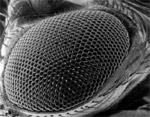The eye of the Drosophila (fruit fly) is characterized by a neat hexagonal patterns, a fascinating system to study pattern formation in biology. A recent paper published in EPJ E proposes a new mechanism to explain the emergence of this pattern.
Researchers at the University of Michigan, Ann Arbor examined a spatially discrete, three variable reaction-diffusion model inspired by the interactions that create a periodic pattern of gene expression in the Drosophila eye. This model creates a regular pattern behind a moving front, as observed in eye discs, through a novel “switch and template” mechanism. In order to better understand this mechanism, the authors performed a detailed study of the model’s behaviour in one dimension, using a combination of analytic methods and numerical searches of parameter space. They find that patterns are created robustly, provided that there is an appropriate separation of time scales and that self-activation is sufficiently strong. The model operates in a strongly nonlinear regime where the final pattern depends on the initial conditions as well as on parameter values. This study highlights the important role that cellularisation and cell-autonomous feedback can play in biological pattern formation.
To read the full paper "Switch and template pattern formation in a discrete reaction-diffusion system inspired by the Drosophila eye" by M.W. Pennington and D.K. Lubensky, Eur. Phys. J. E 33 (2010) click here.






